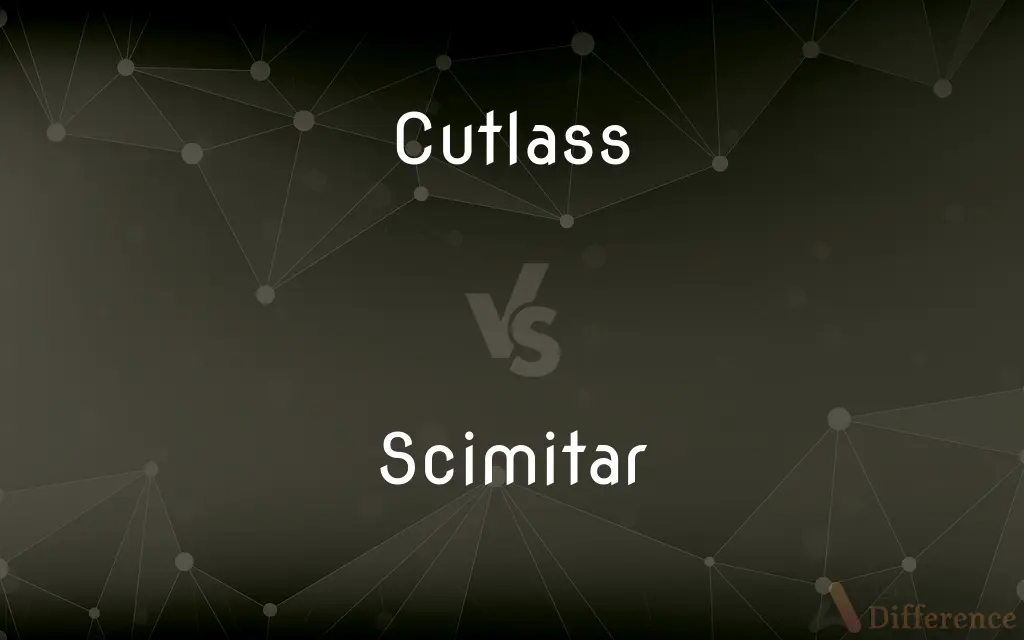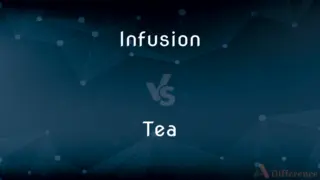Cutlass vs. Scimitar — What's the Difference?
Edited by Tayyaba Rehman — By Fiza Rafique — Updated on October 29, 2023
Cutlass is a short, broad, slightly curved sword, often associated with sailors. Scimitar is a curved sword with a sharp edge on the convex side, commonly linked with Middle Eastern warriors.

Difference Between Cutlass and Scimitar
Table of Contents
ADVERTISEMENT
Key Differences
A cutlass is a type of sword that is short, broad, and slightly curved. Often, when people think of a cutlass, they envision pirates or sailors from the age of naval warfare. The design of the cutlass made it particularly useful for close combat on ships, where space was limited and swift movements were required. In contrast, the scimitar is a sword that boasts a distinct curved blade, sharp on its convex side. It's a design that has its roots in the Middle East and is commonly associated with Arabian warriors.
The cutlass, due to its compact design, became a favored weapon for naval combatants. Its short length provided the advantage in the tight confines of a ship. The scimitar, with its unique curvature, was adept for mounted combat, allowing riders to slash opponents while riding without getting the blade stuck.
In terms of appearance, the cutlass often has a more robust, broader blade compared to the scimitar. The scimitar is characterized by its elegant, slim, and pronounced curve, making it easily identifiable. Both weapons, however, were crafted for swiftness and efficient cutting.
The cultural associations of the two swords also differ. The cutlass is embedded in naval and pirate lore, particularly in the Caribbean and Atlantic contexts. Meanwhile, the scimitar evokes images of the vast deserts of the Middle East, horseback warriors, and ancient empires.
To summarize, while both the cutlass and scimitar are curved swords, they differ in design, use, and cultural associations. The cutlass is broad, short, and has naval ties, while the scimitar is slim, elegantly curved, and rooted in Middle Eastern history.
ADVERTISEMENT
Comparison Chart
Design
Short, broad, slight curve.
Long, slim with a pronounced curve.
Historical Association
Sailors and pirates.
Middle Eastern warriors.
Optimal Use
Close combat, especially on ships.
Mounted combat, slashing attacks.
Cultural Context
Caribbean and Atlantic naval lore.
Middle Eastern deserts and empires.
Blade Edge
Often both sides.
Typically sharp on the convex side.
Compare with Definitions
Cutlass
A naval combat weapon.
The sailor defended the ship with his trusty cutlass.
Scimitar
A curved sword from the Middle East.
The warrior wielded a sharp scimitar.
Cutlass
A broad-bladed weapon.
The cutlass stood out among the other swords due to its width.
Scimitar
A weapon for mounted warriors.
Riding his steed, he struck foes with his scimitar.
Cutlass
A short sword with a slight curve.
The pirate brandished his cutlass menacingly.
Scimitar
A symbol of Arabian combat.
Historical tales often depicted heroes with a scimitar in hand.
Cutlass
A weapon for close combat.
In the tight ship corridors, a cutlass was invaluable.
Scimitar
A sword sharp on its convex side.
The scimitar gleamed in the desert sun.
Cutlass
A sword associated with pirates.
Treasure maps and a cutlass were part of the child's costume.
Scimitar
An elegantly curved blade.
The scimitar's curve was both beautiful and deadly.
Cutlass
A cutlass is a short, broad sabre or slashing sword, with a straight or slightly curved blade sharpened on the cutting edge, and a hilt often featuring a solid cupped or basket-shaped guard. It was a common naval weapon during the early Age of Sail.
Scimitar
A scimitar ( or ) is a backsword or sabre with a curved blade typically associated with Middle Eastern, South Asian, or North African cultures.
Cutlass
A short heavy sword with a curved single-edged blade, once used as a weapon by sailors.
Scimitar
A curved Asian sword with the edge on the convex side.
Cutlass
(Caribbean) A machete.
Scimitar
A sword of Persian origin that features a curved blade.
Cutlass
(nautical) A short sword with a curved blade, and a convex edge; once used by sailors when boarding an enemy ship.
Scimitar
A long-handled billhook.
Cutlass
A similarly shaped tool; a machete.
Scimitar
(transitive) To strike or slice with, or as if with, a scimitar.
Cutlass
(transitive) To cut back (vegetation) with a cutlass.
Scimitar
A curved oriental saber; the edge is on the convex side of the blade
Cutlass
A short, heavy, curving sword, used in the navy. See Curtal ax.
Cutlass
A short heavy curved sword with one edge; formerly used by sailors
Common Curiosities
Are both cutlass and scimitar curved swords?
Yes, but the cutlass has a slight curve while the scimitar has a pronounced curve.
Which sword is better for close combat on ships?
The cutlass is designed for close combat, especially in the confined spaces of ships.
Is the scimitar primarily a Middle Eastern sword?
Yes, the scimitar is rooted in Middle Eastern history and warfare.
What's a key design feature of the scimitar?
The scimitar has a slim, elegantly pronounced curve sharp on its convex side.
Which sword is associated with pirates?
The cutlass is commonly linked with pirates.
Did sailors primarily use the cutlass?
Yes, the cutlass was a favored weapon among sailors and naval combatants.
What cultural imagery does the scimitar evoke?
The scimitar evokes Middle Eastern deserts, horseback warriors, and ancient empires.
Is the scimitar used for mounted combat?
Yes, the scimitar is adept for mounted combat, allowing slashing without the blade getting stuck.
Does the cutlass have a broader blade than the scimitar?
Typically, the cutlass has a broader, robust blade compared to the scimitar.
Is the cutlass primarily a weapon?
While historically a weapon, the cutlass can also be a ceremonial or decorative item today.
Are there different variations of the scimitar?
Yes, there are various regional and historical variations of the scimitar, each with unique designs and uses.
Which is longer, a cutlass or a scimitar?
Generally, a scimitar is longer with a more pronounced curve than a cutlass.
Can a cutlass be sharp on both sides?
Yes, a cutlass can often be sharp on both sides.
Are both swords still used today?
While not common in warfare, both the cutlass and scimitar are seen in ceremonies, collections, and martial arts.
How did the design of the scimitar benefit mounted warriors?
The scimitar allowed for swift slashing attacks without the blade getting stuck, ideal for mounted combat.
Share Your Discovery

Previous Comparison
Peen vs. Teen
Next Comparison
Infusion vs. TeaAuthor Spotlight
Written by
Fiza RafiqueFiza Rafique is a skilled content writer at AskDifference.com, where she meticulously refines and enhances written pieces. Drawing from her vast editorial expertise, Fiza ensures clarity, accuracy, and precision in every article. Passionate about language, she continually seeks to elevate the quality of content for readers worldwide.
Edited by
Tayyaba RehmanTayyaba Rehman is a distinguished writer, currently serving as a primary contributor to askdifference.com. As a researcher in semantics and etymology, Tayyaba's passion for the complexity of languages and their distinctions has found a perfect home on the platform. Tayyaba delves into the intricacies of language, distinguishing between commonly confused words and phrases, thereby providing clarity for readers worldwide.















































